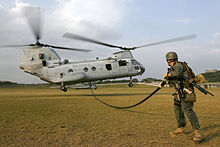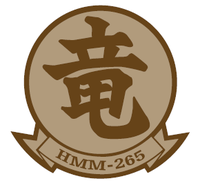- HMM-265
-
Marine Medium Helicopter Squadron 265
HMM-265 insigniaActive - October 1, 1962- November 13, 1970
- September 1, 1977 - present
Country United States Allegiance United States of America Branch United States Marine Corps Type Medium-lift helicopter squadron Role Conduct assault support operations for the Fleet Marine Forces Part of Marine Aircraft Group 36
1st Marine Aircraft WingGarrison/HQ Marine Corps Air Station Futenma Nickname "Dragons" Motto "Fix, Fly, Promote" Tail Code EP Engagements Vietnam War
* Operation Hastings
Operation Desert Storm
Operation Sea Angel
Operation Desert Fox
Operation Iraqi FreedomCommanders Current
commanderLtCol Damien M Marsh Marine Medium Helicopter Squadron 265 (HMM-265) is a United States Marine Corps helicopter squadron consisting of CH-46E Sea Knight transport helicopters. The squadron, known as the "Dragons", is based at Marine Corps Air Station Futenma, Okinawa, Japan and falls under the command of Marine Aircraft Group 36 (MAG-36) and the 1st Marine Aircraft Wing (1st MAW).
Contents
Mission
Support the Marine Air-Ground Task Force (MAGTF) Commander by providing assault support transport of combat troops, supplies and equipment, day or night under all weather conditions during expeditionary, joint or combined operations.
History
Early years
HMM-265 was commissioned on October 1, 1962 at Marine Corps Air Facility Jacksonville, North Carolina. Originally flying the UH-34, the squadron deployed to Memphis, Tennessee shortly after commissioning in support of the Mississippi Crisis, a critical moment in the American civil rights movement. Following that, HMM-265 began a series of deployments testing new helicopter tactics such as the night raid.
That day of destiny for HMM-265 occurred on June 29, 1964 as BUNO 150942 was flown for 3.4 hours to the squadron’s home at MCAF Jacksonville. By July of that year, the squadron began accepting Sea Knights and is the first FFleet Marine Force squadron to fly the aircraft.[1] To commemorate their new aircraft, the Dragons of HMM-265 unveiled a new insignia on October 1, 1964. This design, created by PFC Charles D. Lyles, was the official unit patch until 2007, when a new design was adopted, based on the Japanese Shinjitai for dragon: . On February 4, 1966, as HMM-265 became the first Marine Squadron to log 10,000 accident free hours in the CH-46A. This is a great achievement in an era when the CH-46 was going through the growing pains that occur when a new aircraft is fielded.
Vietnam War
In April 1966, HMM-265 boarded the USS Boxer (LPH-4) in Norfolk, Virginia. On May 22, 1966, the squadron arrived in Vietnam at the Marble Mountain Air Facility located southeast of Da Nang Air Base. The squadron had 22 CH-46As and was assigned to Marine Aircraft Group 16, 1st Marine Aircraft Wing.
On July 15, 1966, during the first day of Operation Hastings, HMM-265 had two of its helicopters crash. The first crash was caused when a CH-46A struck a tree during the initial insert of Marines from 3rd Battalion, 4th Marines and the second occurred later that evening when aircraft EP-171 was hit at 1,500 feet by 12.7mm fire resulting in the death of 13 Marines.[2][3] In addition to daily missions transporting Marines and cargo, HMM-265 and its Sea Knights flew in support of Operation Macon from July 4 through October 27, 1966. HMM-265 along with HMM-164 conducted multiple battalion insertions to allow the 3rd Marine Division to conduct multiple search and destroy missions in the An Hoa region. 12th Marines artillery and Marine A-4 Skyhawks fired on landing zones prior to the CH-46s landing.
The other major operation in 1966 was Operation Prairie (August 3 – September 13). The Dragons supported the 4th Marine Regiment as they battled for the Nui Cay Tre (Mutter) Ridge. Landing in “hot” zones under heavy enemy fire marked this battle, a harbinger of future battles in Vietnam.
In July 1967, HMM-265 became the Special Landing Force (SLF) helicopter squadron embarked aboard the 7th Fleet’s Amphibious Ready Group. As the SLF squadron, the Dragons were tasked with conducting heliborne search and destroy missions against Viet Cong targets along the coast. During this time, five major operations were conducted with names such as Bear Chain/Fremont, Beacon Guide, Kangaroo Kick, Beacon Gate, and Cochise.
The Dragons resumed duties as the SLF squadron aboard the USS Iwo Jima (LPH-2) in May 1969. They conducted amphibious raids in support of Operations Bold Pursuit (June 27 – July 6), Mighty Play (July 10 – July 20), and finally Defiant Stand (September 7 – September 18). After three years in Vietnam, the war-weary squadron was relocated to Marine Corps Air Station Santa Ana, California on October 10, 1969 leaving their helicopters with other in-country squadrons. A total of twenty-seven HMM-265 Marines perished in the war. HMM-265 was rebuilt using a few squadron personnel returned from Vietnam and the Marines of HMMT-301. The CH-46A helicopters left behind in Vietnam were replaced by the CH-46 Super D from overhaul. The squadron was deactivated on November 13, 1970.
On September 1, 1977, HMM-265 was reactivated at Marine Corps Air Station Kaneohe Bay, Hawaii, reestablishing a presence in the Pacific that continues to this day. On the day of reactivation, the squadron had no helicopters, and by December it was almost at a full strength of 4 CH-46Ds and 7 CH-46Fs. The Dragons of HMM-265 were relocated entirely to Marine Corps Air Station Futenma, Okinawa Japan in early 1995.
 CH-46 of HMM-265 lands on the deck of the USS Essex (LHD-2) in January 2004
CH-46 of HMM-265 lands on the deck of the USS Essex (LHD-2) in January 2004
The Gulf War & the 1990s
In 1990 and 1991 the Dragons were attached to the 5th Marine Expeditionary Brigade, Marine Air Group 50. During Operation Desert Shield, they took part in Operation Sea Soldier IV the largest NVG troop lift ever in Marine Corps history in the country of Oman. The squadron then waited on amphibious shipping in the Persian Gulf awaiting the start of combat operations. The Dragons were part of the 5th Marine Expeditionary Brigade’s amphibious feint into Kuwait, which succeeded in drawing the attention of Saddam Hussein’s forces away from the actual attack that occurred inland.
Upon conclusion of hostilities in the Persian Gulf region, HMM-265 returned to Hawaii. While en route, they were called upon to provide humanitarian assistance and disaster relief to the country of Bangladesh during Operation Sea Angel. During the operation the Dragons flew 770 Phrog hours in ten days.
 A CH-46E from HMM-265 training at Camp Hansen on Okinawa on January 31, 2007.
A CH-46E from HMM-265 training at Camp Hansen on Okinawa on January 31, 2007.
The squadron had little time to rest before deploying to Okinawa in October 1991. During this deployment the Dragons provided support to HMX-1 for the Presidential visit to Tokyo. The Dragons were then called to Cambodia in support of Operation Full Accounting in 1992, where they assisted in the recovery of remains of US Servicemen lost during the Vietnam War.
Heightened tensions in the Persian Gulf during the fall of 1998 brought the Dragons back on a no-notice deployment as the Aviation Combat Element (ACE) for the 31st Marine Expeditionary Unit. They participated in Operation Desert Fox in the Persian Gulf and Kuwait from November 1998 through February 1999. When the squadron returned, they had a short break before deploying again. This time, the Marines helped end a bloody civil war on the small island country of East Timor during Operation Stabilise in October 1999 and again during January and February 2000.
Global War on Terror
Deployed in support of Operation Iraqi Freedom operating from Al Asad Airbase, Al-Qa'im, and Korean Village from October 2004 to February 2005.
Awards
- Marine Corps Aviation Association’s Squadron of the Year for 1992, 1999, 2000 and 2009.
- Chief of Naval Operations Safety Award for the years 1978, ‘79, ‘84, ‘94, ‘95, ‘96, ‘97, and 2009.
- The squadron surpassed 60,000 mishap free flight hours in the fall of 2003.
Notes
References
 This article incorporates public domain material from websites or documents of the United States Marine Corps.
This article incorporates public domain material from websites or documents of the United States Marine Corps.
- Bibliography
- Coan, James P. (2004). Con Thien - Hill of Angels. Tuscaloosa, Alabama: The University of Alabama Press. ISBN 0-81731-414-8.
- Mersky, Peter B. (1983). U.S. Marine Corps Aviation - 1912 to the Present. Nautical and Aviation Publishing Company of America. ISBN 0-933852-39-8.
- Sturkey, Marion F. (1997). BONNIE-SUE: A Marine Corps Helicopter Squadron in Vietnam. Heritage Press International. p. 509. ISBN 0-96508-142-7.
- Web
MAG-12 
MAG-24 MAG-36 MACG-18 MWSG-17 Categories:- United States Marine Corps helicopter squadrons
Wikimedia Foundation. 2010.



